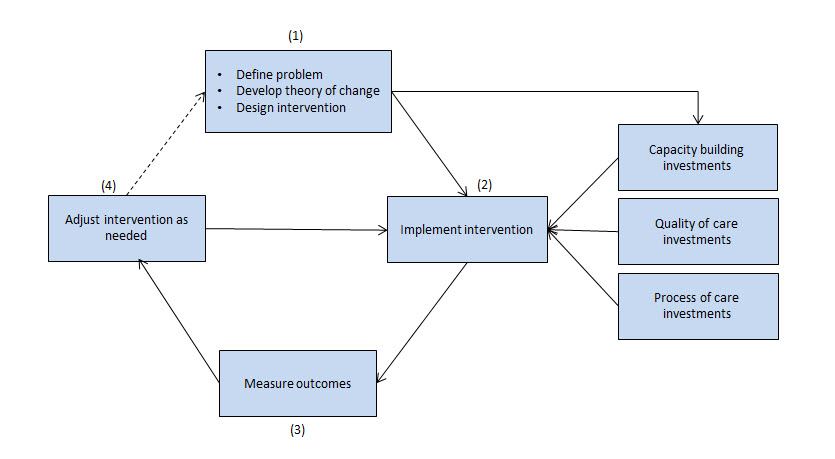Continuous Quality Improvement in Child Welfare
The Data Center works closely with child welfare agencies to establish CQI structures and promote their use. Our core CQI model begins with an assessment of the agency’s baseline performance on central outcomes pertaining to child safety, permanence, and well-being. In the next step, we provide analytic and decision support to help the agency set performance targets and select strategies (i.e., interventions) for reaching them. Introducing new interventions requires the agency to invest in three major areas: the quality of services to be delivered, the processes by which they are delivered, and the capacity of the agency to deliver them with fidelity. Once interventions are implemented, the cycle of CQI involves a feedback loop of performance measurement, analysis, and investment adjustment; after an established period of time, performance is assessed to determine the return on the agency’s investments, the agency uses those outcomes to modify its future investments as necessary, and the cycle continues.
Selected Publications:
Within and Between State Variation in the Use of Congregate Care
Fred Wulczyn, Lily Alpert, Zach Martinez, & Ava Weiss | 2015
Despite the mandate to place children in foster care in the least restrictive environment possible, the practice of placing children in congregate care settings persists in most places around the country. The question is why and what can be done, from a policy perspective, to ensure that group care is used for the children and youth who need it most. Answering that question begins with learning how the use of group care varies in different parts of the country and why.
In the new research brief Within and Between State Variation in the Use of Congregate Care we illustrate how reliance on group care placement differs throughout the country and explore how child characteristics (age, race/ethnicity, and gender) influence the odds of being placed in a group setting. We then take that analysis to the next level by examining how attributes of place such as urbanicity and socioeconomic characteristics contribute to the likelihood of placement in group care. The contextual approach adds a critical perspective to conversations regarding the allocation of congregate care resources as it raises important questions about how system dynamics shape agencies’ ability to match the supply of congregate care resources to their true demand.
Download the brief >
Principles, Language, and Shared Meaning: Toward a Common Understanding of CQI in Child Welfare
Fred Wulczyn, Lily Alpert, Britany Orlebeke, & Jennifer Haight | 2014
Today, child welfare agencies are taking stock of their capacity for CQI and considering the investments they will make in order to build that capacity. While the structure of CQI systems will differ from one agency to the next, all of them will be responsible for supporting the same basic CQI process—a cycle of problem solving activities that requires the deliberate use of evidence. In this paper we propose a fundamental vocabulary for describing what CQI is, the core principles on which CQI rests, and the critical role that evidence plays throughout the CQI process.
Download the PDF >
Foster Care Utilization among School-age Children
Lily Alpert | 2013
How many school-age children are in foster care, when during the school year do they enter the system, and how long do they stay in care? The answers to these questions have implications for practice and resource allocation in both the child welfare and education sectors.
Download PDF >
Monitoring Child Welfare Programs: Performance Improvement in a CQI Context
Fred Wulczyn | 2007
Using permanency outcomes for children placed in foster care (e.g., reunification or adoption), we illustrate some of the issues encountered when attempting to use baselines to establish goals and monitor progress.
Download the PDF >
Framing Analytic Questions in the Context of Continuous Quality Improvement
2012
Read this post from the Data Center’s user-support blog, Recipes, about how longitudinal data can help your agency answer questions about system performance throughout the cycle of continuous quality improvement.
Read the post >
Performance-Based Contracting in Tennessee
Jennifer Haight
In 2005, Tennessee’s Department of Children’s Services engaged the Data Center in an effort to improve outcomes for children placed with contracted private services providers. We helped the state design and implement a performance- based contract that led to improved permanency for children and $20 million in savings to the state over five years.
Read the fact sheet >
Finding the Return on Investment: A Framework for Monitoring Local Child Welfare Agencies
Fred Wulczyn, Britany Orlebeke, Jennifer Haight | 2009
From year to year, child welfare directors allocate resources in the hope that their efforts will improve children’s outcomes. In this paper, we present a framework that state and local child welfare agencies can use to monitor their return on those investments. Focusing on traditional child welfare outcomes pertaining to child maltreatment and foster care, the goal is to burrow through the complexity involved in understanding whether system performance is improving and whether the improvements are connected to changes in how resources are invested.
Download the PDF >
Online Continuous Quality Improvement Seminars:
Online CQI Seminars introduce child welfare administrators to basic concepts of longitudinal data analysis and their applications to the cycle of CQI. View the slides from our recent CQI seminars:
